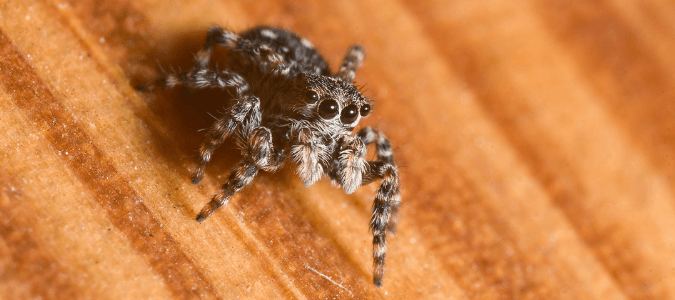
Ever seen a jumping spider? Chances are, if you live in Texas you have—and seeing it move so quickly in its trademark jerky, hopping manner probably either made you lean closer in curiosity or gave you the shock of your life, if not both. There are a few things about a jumping spider Texas homeowners need to know: For starters, these little critters are no scarier than any other eight-legged arachnid. They’re just startling because they move so far, so quickly! Their appearance may seem a bit threatening, however. When crossing paths with one of these, any reasonable person might wonder, do jumping spiders bite? Let’s find out more about the jumping spider to learn where they live, whether they bite people and what to do when you find them living in your home.
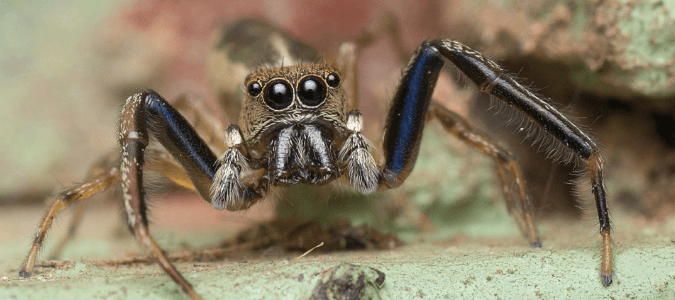
Do Jumping Spiders Bite?
Before we discuss whether jumping spiders bite, let’s first learn how to identify these critters. They are somewhat small; many species of adult jumping spiders reach only about a half-centimeter or less in length, while other, larger species might grow just a bit larger than that, reaching a half-inch or so. Jumping spiders have fuzzy bodies that are gray or black, usually with spots on their abdomens that may be white, orange or red. A jumping spider’s head is typically large for its body and maybe even larger than its abdomen. Some species of jumping spider have a blue spot on their heads, but most have heads that are all black or gray in color.
Jumping spiders’ eyes are very unique. They have eight eyes total, six of which are positioned around the head to give the spider a 360-degree view of its surroundings. The other two eyes are larger than the others and are set at the front of the spider’s head, and are pretty uniquely formed: They are essentially a tube, less than a millimeter long, that is topped with a lens and filled with a clear gel that functions as a second lens. This eye structure acts like a tiny pair of binoculars, giving the jumping spider very good three-dimensional vision. Only two other types of animal—chameleons and falcons—are known to have eyes formed in this same way. The jumping spider’s eyes allow it to track its prey with accuracy and efficiency, so it can pounce on it, grab it and bite into it for a meal.
As for their prey, jumping spiders typically eat insects like caterpillars and bugs; sometimes, they also eat other spiders. Fortunately, they do not feed on humans. If disturbed—for example, if poked or squeezed by a human—a jumping spider may bite in self-defense, but their bites are harmless. Even if a small child or pet is bitten by a jumping spider, the spider’s bite is not venomous and therefore shouldn’t be harmful. Certain people might have a minor reaction to a jumping spider bite, such as itching or irritation at the site of the bite, but symptoms like these aren’t common and shouldn’t last long.
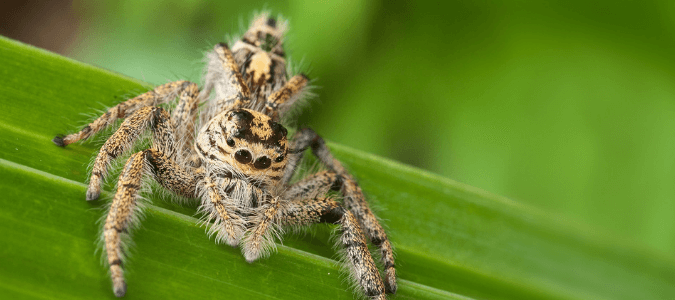
Where Do Jumping Spiders Live?
Various species of jumping spiders are found all over the United States, Mexico, and Canada. Believe it or not, there are over 100 species of jumping spider in Texas alone! The most common type of jumping spider is the bold jumping spider.
Interestingly, you won’t find jumping spiders in a web, as they don’t spin, live in or catch food with webs. Instead, they hunt for their prey on foot, during the daytime. Female jumping spiders do spin silk to build a nest, called a retreat, for hiding in while they lay eggs and then for protecting the eggs until they hatch into baby spiderlings.
These retreats, which look like small, soft, white, fuzzy masses, are often spun in secure spots like in dry plant leaves or against the crevices of rocks. Adult jumping spiders might use these retreats in the winter along with their eggs and spiderlings to stay warm and safe until warmer weather returns. Jumping spiders can also spin a single thread of silk to use for safety, similar to a tether line, when they’re exploring or jumping a particularly far distance.
Jumping spiders typically live on plants that have broad leaves, like milkweed, or on wood such as tree trunks, fence posts or the siding on houses, garages or barns.
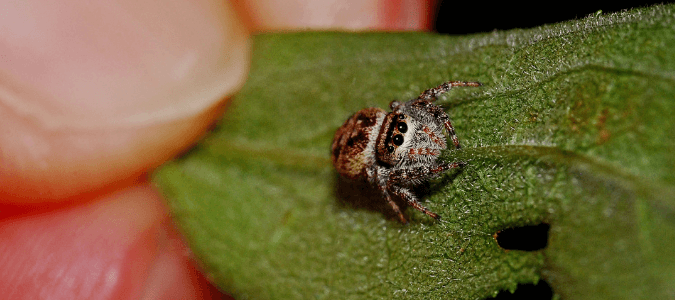
What Species Is A Small Jumping Spider?
A small jumping spider is just one of many jumping spider species (again, there are over 100 species of this type of spider in Texas alone). Some species of jumping spider are brown, while others are black, and most have tiny hairs all over their bodies and legs. Jumping spiders are typically pretty small; as we already mentioned, most species of this spider do not get much larger than a quarter-inch to a half-inch long, though the females of some species might reach as large as three-quarters of an inch in length. Almost all jumping spiders have two front legs that are longer and heavier than their other legs, which makes them look like tiny bodybuilders—quite in keeping with their ability to jump distances many times their own size.
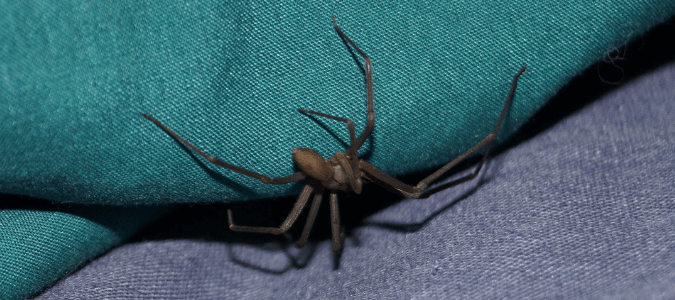
Which Texas Spider Species Should Homeowners Avoid?
While jumping spiders and tarantulas in Texas are not much of a threat to homeowners, there are two main Texas spider species that are of real concern, especially for people with children and pets: the black widow and the brown recluse. Both of these spiders are venomous, with bites that can make people very ill (black widow bites have even been known to cause death on rare occasion). If you’ve ever lived in Texas, there’s a good chance you’ve at least heard of these two types of spider, if not actually encountered them face to face.
Black widow spiders are renowned for their venomous bite, which can make people very sick. They are also known for the creepy fact that the females often consume the males after mating (hence their name). Female black widows have black bodies that are about a half-inch long, and long, black legs; they also have telltale markings on the underside of their large, bulbous abdomens. Usually reddish-orange but sometimes yellow, these markings might be in the shape of an hourglass or just a simple dot.
Male black widows are smaller than their female counterparts, and they don’t have the large abdomen or the all-black coloring of female black widows. Instead, the males of this species are rather slim, with mottled gray or brown coloring. Males are also not as venomous as females. Fortunately, black widows aren’t aggressive toward humans; they generally bite people only when they are surprised or disturbed. Their bites can be serious, though, and typically cause swelling at the site of the bite along with muscle aches and weakness, nausea, headaches, and vomiting.
Similar to black widows, brown recluse spiders are about a half-inch long, with narrow abdomens and long legs. They range from sand-brown to dark-brown in color, with a slightly darker spot at the center of their abdomens. They also have a distinctive darker-brown marking on their heads that many people say is shaped like a violin. Another common Texas spider, the grass spider, is often mistaken for a brown recluse. While grass spiders are a similar color, size and shape to brown recluses, they have distinctive dark-brown stripes on their backs instead of the smooth coloring of the brown recluse, and their bodies are narrower and more angular in shape.
Brown recluse bites may sting at first, and over the course of several hours, they start to become more and more uncomfortable. The area around the bite might become discolored or form a blister. Other symptoms of a brown recluse bite include fever and nausea, along with itching and muscle pain. The venom injected when a brown recluse spider bites a person can be strong enough that it actually causes tissue damage around the site of the bite; occasionally, a person will have a brown recluse bite serious enough that a skin graft is needed.
Both black widow and brown recluse spiders tend to make their homes in dark, protected spaces, such as wood and rock piles, behind or beneath furniture or inside boxes of old items in storage. For this reason, it’s smart to be careful and wear gloves when poking around in areas like these. If you do suspect you’ve been bitten by one of these spiders, ice the area and get to a medical professional as soon as possible for diagnosis and medication, if needed.
Scared Of Spiders? ABC Can Help!
It’s no surprise that after discovering a jumping spider, black widow, brown recluse, or even a wolf spider, Texas homeowners most often have the initial urge to run in the opposite direction. Fortunately, unlike black widows and brown recluses, jumping spiders are essentially harmless to humans (aside from the sense of shock they might cause when leaping quickly from one spot to another!). Since they eat insects as well as other spiders, jumping spiders might even be considered less of a pest and more of a helpful critter to have around. Most people, of course, don’t want jumping spiders or any other type of spider inside their homes. So what should you do if you find jumping spiders in your living space?
If you have unwelcome arachnid housemates that you’d like to get rid of, call on ABC Home & Commercial Services. An indoor spider problem is generally a sign of an insect problem in general. At ABC, our pest control experts are experienced in eliminating all types of unwanted pests, including jumping spiders. We can treat your home and other living spaces for spiders as well as for the insects they’re feeding on, to ensure that you won’t have to deal with creepy-crawly critters any longer.
